A non viscous liquid of constant density 10^(3) kg//m^(3) flows in stream line motion along a tube of variable cross-section. The tube is kept inclined in the verticaly plane as shown in Fig. The area of cross section of the tube at two points P and Q at heights if 2 m and 5 m are respectively 4×10−3m2 and 8×10−3m2 . Find the work done per unit volume by pressure and gravity forces as liquid flows from P to Q.
 Solution in Punjabi
Solution in Punjabi
Step by step video & image solution for A non viscous liquid of constant density 10^(3) kg//m^(3) flows in stream line motion along a tube of variable cross-section. The tube is kept inclined in the verticaly plane as shown in Fig. The area of cross section of the tube at two points P and Q at heights if 2 m and 5 m are respectively 4xx10^-3 m^2 and 8xx10^-3m^2 . Find the work done per unit volume by pressure and gravity forces as liquid flows from P to Q. by Physics experts to help you in doubts & scoring excellent marks in Class 11 exams.
Updated on:21/07/2023Topper's Solved these Questions
Similar Questions
Distinguish between streamline and turbulent flow of a liquid.
View SolutionDiscuss stress-strain graph.
View SolutionAn elevator weighs 4000kg When the upward tension in the supporting cable is 48000 N what is the upward acceleration? Starting from rest, how far does it rise in 3 seconds ?
View SolutionA non-viscous liquid of constant density 1000kg/m3 flows in a streamline motion along a tube of variable cross section. The tube is kept inclined in the vertical plane as shown in Figure. The area of cross section of the tube two point P and Q at heights of 2 metres and 5 metres are respectively 4×10−3m2 and 8×10−3m2. The velocity of the liquid at point P is 1m/s. Find the work done per unit volume by the pressure and the gravity forces as the fluid flows from point P to Q.
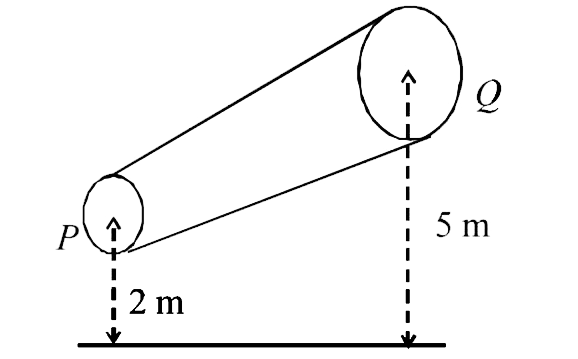
View SolutionA non-viscous liquid of constant density 500kg/m3 flows in a variable cross-sectional tube. The area of cross section of the tube at two points P and Q at heights of 3m and 6m are 2×10−3m3 and 4×10−3m3, respectively. Find the work done per unit volume by the forces of gravity as the fluid flows from point P to Q.

View SolutionFigure shows a liquid flowing through a tube at the rate of 0.1 m^(3)//s . The tube is branched into two semicircular tubes of cross-sectional area A//3 and 2A//3 . The velocity of liquid at Q is (the cross section of the main tube is A =10^(-2) m^(2) and v_(p) = 20 m//s )
View SolutionA liquid of density 800 kg//m^3 flowing steadily in a tube of varying cross-section. If area of cross-section at A is 4 cm^2 and at B is 2 cm^2 . If speed of liquid at A is 10 cm//s , calculate (i) the rate of flow (ii) the difference in pressures at A and B .
View SolutionA non viscous liquid of constant density 10^(3) kg//m^(3) flows in stream line motion along a vertical tube PQ of variable cross-section. Height of P and Q are 2m and 2.5m respectively. Area of tube at Q is equal to 3 times the area of tube at 'P'. Then work done per unit volume by pressure as liquid flows from P and Q. Speed of liquid at 'P' is 3 m//s .
View Solution(i) Air (density=ρ) flows through a horizontal venturi tube that discharges to the atmosphere. The area of cross section of the tube is A1 and at the constriction it is A2. The constriction is connected to a water (density=ρ0) tank through a vertical pipe of lenght H. Find the volume flow rate (Q) of the air through tube that is needed to just draw the water into the tube.
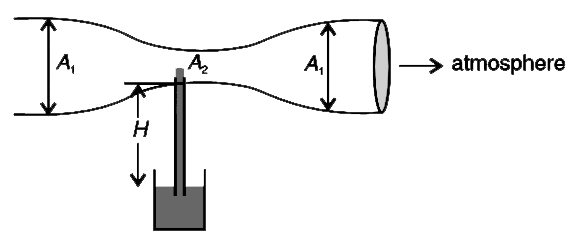
(ii) A non viscous liquid of constant density ρ flows in a stremline motion along a tube of variable cross section. The tube is kept inclined in the vertical plane as shown in the figure. The area of cross section of the tube at two points P and Q at heights of h1 and h2 are respectively A1 and A2. The velocity of the liquid at point P is v. Find the work done on a small volume ΔV of fluid by the neighbouring fluid as the small volume moves from P to Q.
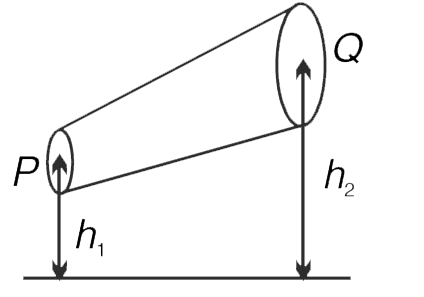
View Solution1000 kg/m3 के नियत घनत्व का एक अश्यान द्रव धारा रेखीय प्रवाह में परिवर्ती अनुप्रस्थ-काट की एक नलिका में बहता है। नली ऊर्ध्वाधर तल में तिरछी रखी गयी है। दो बिंदुओं P तथा Q पर जिनकी ऊँचाइयाँ 2 तथा 5 मी है, नली के अनुप्रस्थ-काट के क्षेत्रफल क्रमशः 4×10−3 m2 तथा 8×10−3 m2 है। बिन्दु P पर द्रव का वेग 1 मी/से है। द्रव के बिन्दु P से Q तक बहने में दाब तथा गुरुत्वीय बलों द्वारा प्रति एकांक आयतन के लिए किए गए कार्य ज्ञात कीजिए।
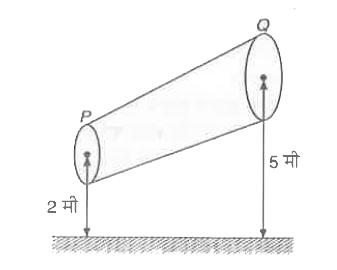
View SolutionA non-viscous fluid of constant density of 1000kg/m3 flows in stream line motion along a tube of variable cross-section
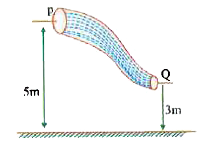 The area of cross-section at two P and Q at lengths 5m are 40cm2and20cm2 respectively. If velocity of fluid at P is 3m/s then find velocity of fluid at Q.
The area of cross-section at two P and Q at lengths 5m are 40cm2and20cm2 respectively. If velocity of fluid at P is 3m/s then find velocity of fluid at Q.
View Solution1000kg/m3 नियत घनत्व वाला अश्यान तरल, एक परिवर्ती अनुप्रस्थ काट की नली के अनुदिश धारा रेखीय रूप से प्रवाहित होता है।

दो बिन्दुओं P व Q जो 5m व 3m ऊँचाई पर है, पर अनुप्रस्थ काट क्षेत्रफल क्रमशः 40cm2 व 20cm2 है। P पर तरल का वेग 3 m/s है Q पर तरल का वेग क्या होगा?
View SolutionA cylindrical tube with a frictionless piston ends in a small hole of area of cross–section 2×10−6m2, which is very small as compared to the area of cross-section of the tube. The tube is filled with a liquid of density 104kg/m3. The tube is held horizontal and the piston is pushed at a constant speed so that liquid comes out of the hole at a constant rate 'Q'm3/s. No liquid leaks around the piston. The material of the tube can bear a maximum pressure 6×105 Pa. The maximum possible value of Q so that the tube does not break is __________ ×10−5m3/s. [Atmospheric pressure =105 Pa]

View SolutionA non-viscous liquid of constant density 1000kg/m3 flows in a streamline motion along a tube of variable cross section. The tube is kept inclined in the vertical plane as shown in Figure. The area of cross section of the tube two point P and Q at heights of 2 metres and 5 metres are respectively 4×10−3m2 and 8×10−3m2. The velocity of the liquid at point P is 1m/s. Find the work done per unit volume by the pressure and the gravity forces as the fluid flows from point P to Q.

View SolutionA non-viscous liquid of constant density 500kg/m3 flows in a variable cross-sectional tube. The area of cross section of the tube at two points P and Q at heights of 3m and 6m are 2×10−3m3 and 4×10−3m3, respectively. Find the work done per unit volume by the forces of gravity as the fluid flows from point P to Q.

View SolutionFigure shows a liquid flowing through a tube at the rate of 0.1m3/s. The tube is branched into two semicircular tubes of cross-sectional area A/3 and 2A/3. The velocity of liquid at Q is (the cross section of the main tube is A=10−2m2 and vp=20m/s)
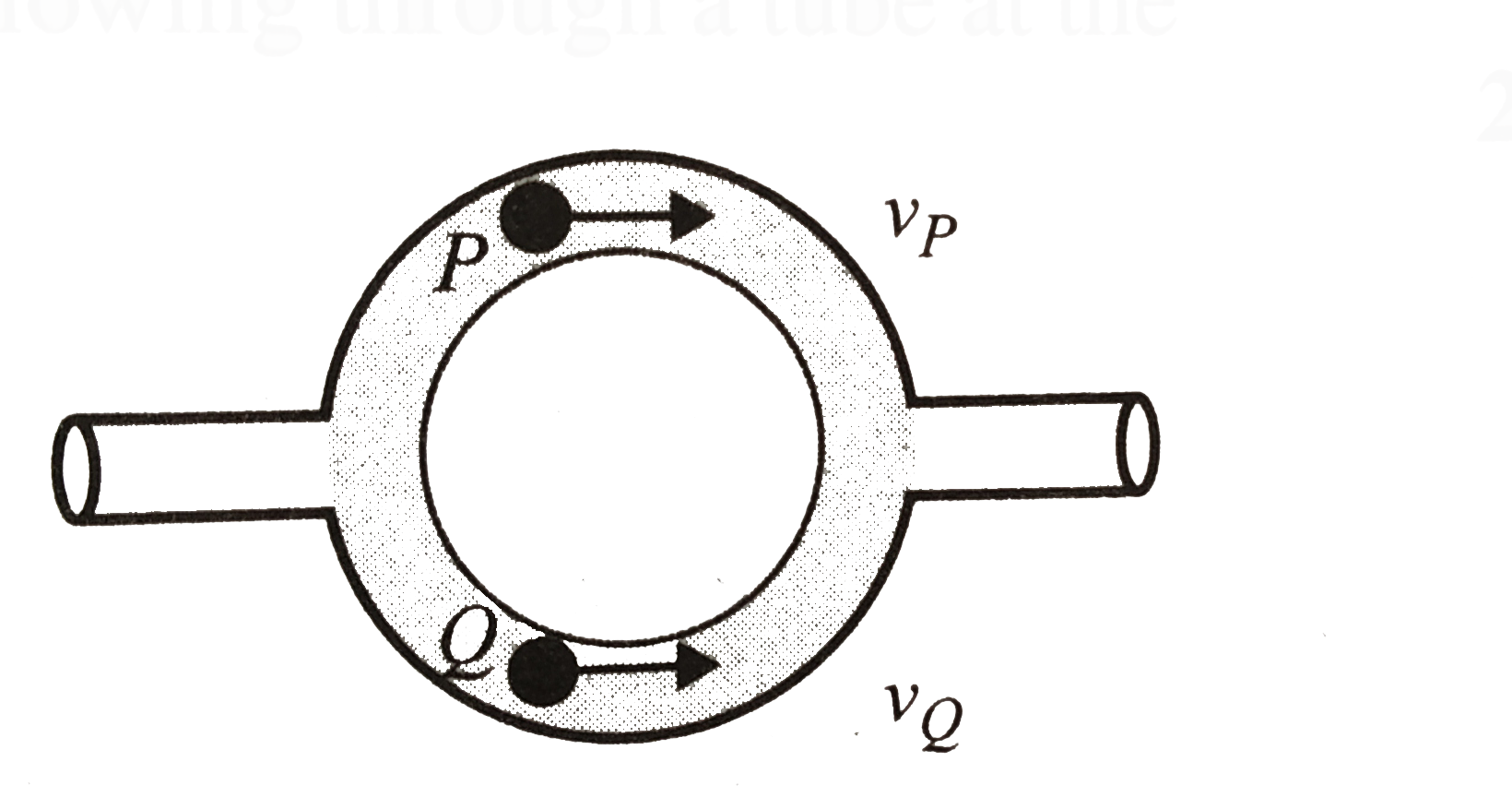
View Solution
